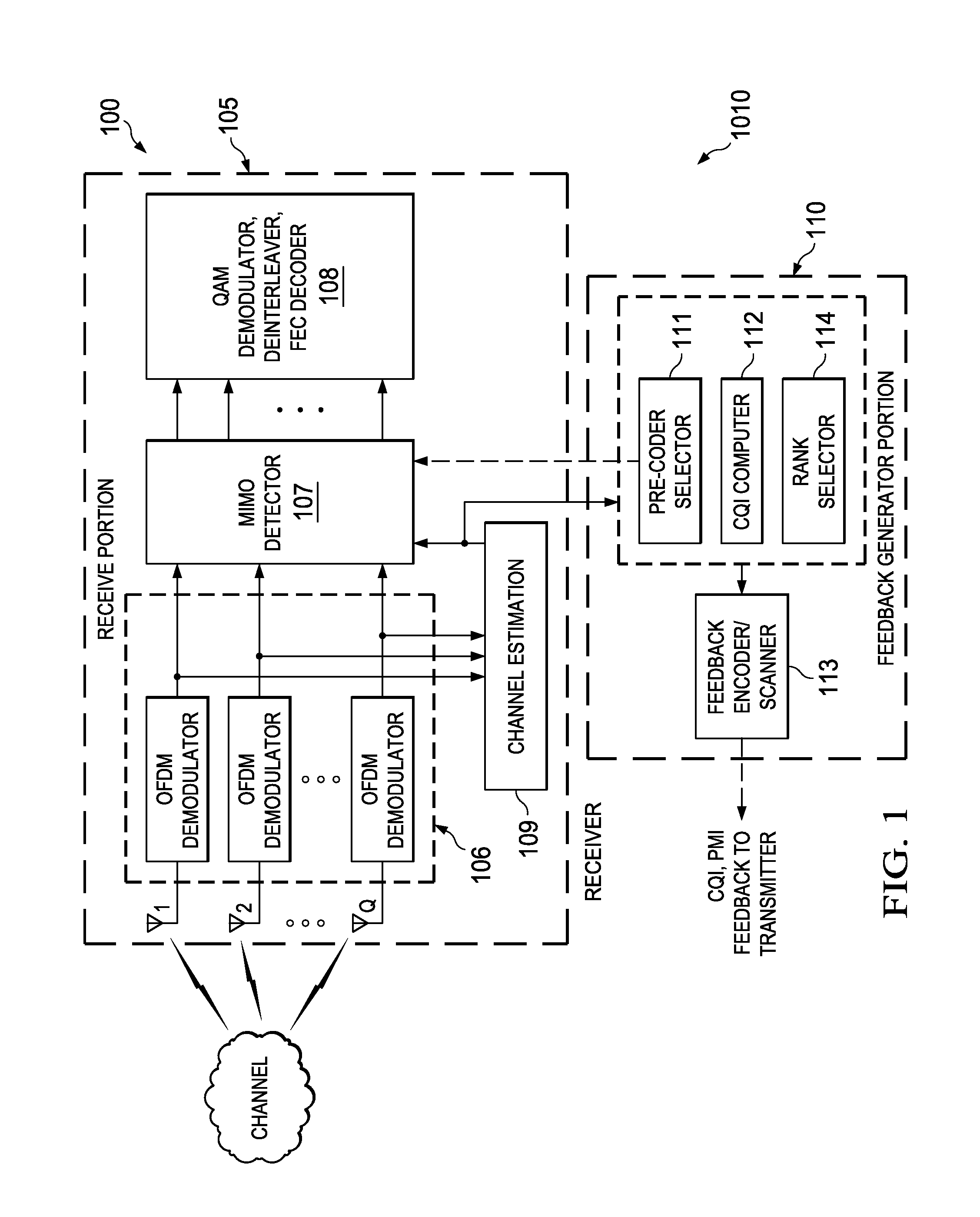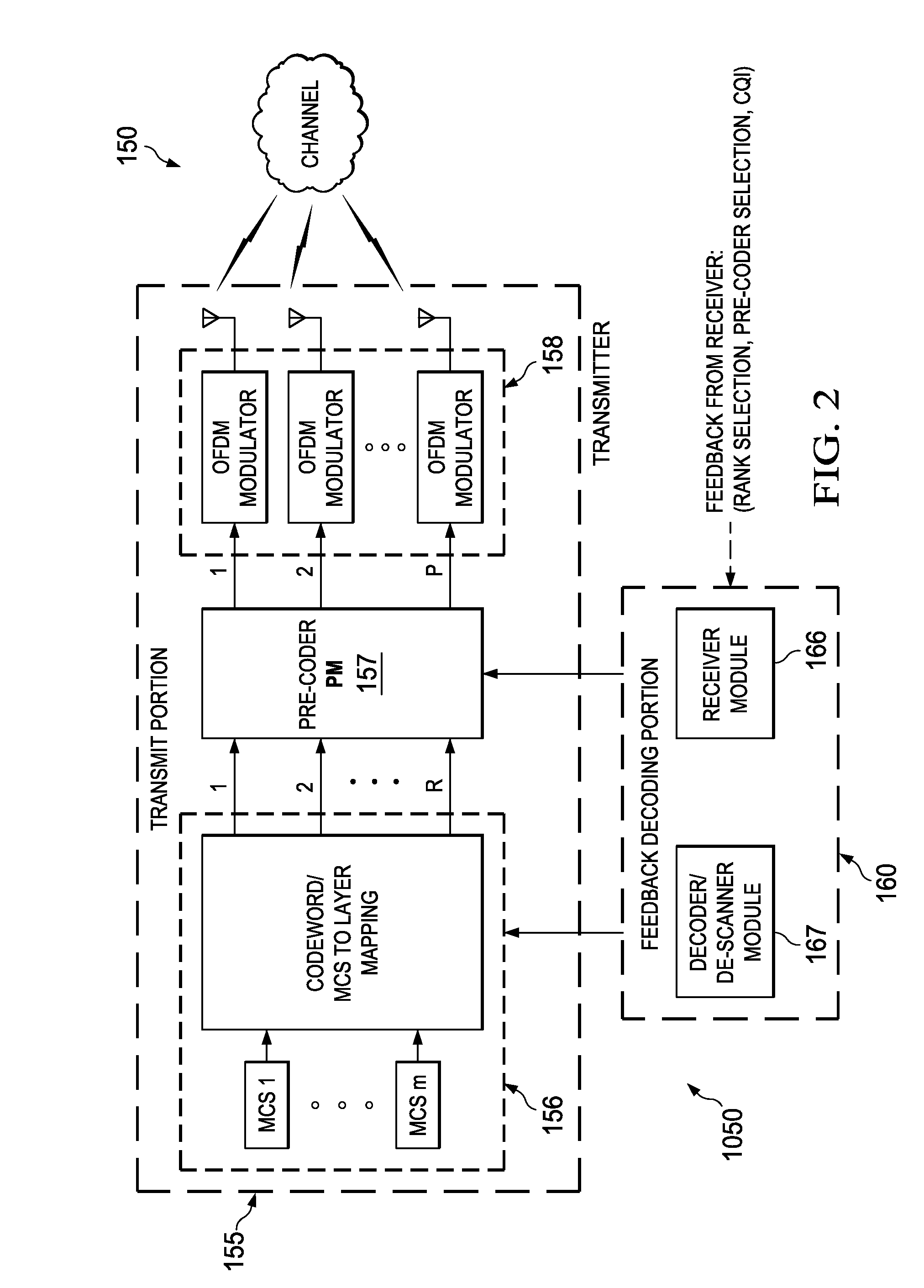Channel quality report processes, circuits and systems
a channel quality and circuit technology, applied in the field of electronic circuits, can solve problems such as interference and noise, undesired increase of system processing delays and power dissipation, and affect the monitoring of receivers
- Summary
- Abstract
- Description
- Claims
- Application Information
AI Technical Summary
Benefits of technology
Problems solved by technology
Method used
Image
Examples
first embodiment
[0213]Uplink feedback 3670 is provided in any of a variety of embodiments related to FIG. 41 and described next. In a first embodiment, a CQI report vector is expressed as (SV, uF1, sF1, uΔr, sDr). In words, the CQI report vector has subband vector SV, the FIG. 21 mean / median / wideband collective CQI sF1 for the selected subbands for codeword CW1 and the FIG. 21 mean / median / wideband collective CQI uF1 for the unselected subbands for codeword CW1. The CQI report also includes the spatial CQI differences sDr between collective CQI sFr for the selected subbands relative to sF1 for codeword CW1. The CQI report further has the spatial CQI differences uΔr relative to CQI uF1 for the unselected subbands for codeword CW1. This is called vertical CQI reporting herein because the spatial CQI differences can be listed in columns vertically in TABLE 2. When spatial CQIs are quite similar in magnitude across code words r, and vertical CQI reporting delivers compression because both the spatial CQ...
third embodiment
[0215]In a third embodiment related to FIG. 41, a CQI report vector is expressed as (SV, sF1, sDr, −suDr), see also TABLE 4. In words, the CQI report vector has subband vector SV, the FIG. 21 mean / median / wideband collective CQI sF1 for the selected subbands for codeword CW1. (uF1 need not be explicitly reported.) The CQI report also includes the spatial CQI differences sDr for other spatial codewords relative to CQI sF1 for the selected subbands for codeword CW1. A reverse-horizontal CQI report usDr=−suDr=uFr−sFr delivers CQI differences in a given row for each codeword, r=1,2, . . . R.
TABLE 4BEST-m CQI REPORTING (“REVERSE-HORIZONTAL”)UnselectedSelectedSub-bandsSub-bandsCW1−suD1sF1CW2, etc.−suDrsDr
fourth embodiment
[0216]In a fourth embodiment category related to FIG. 41, any of the first three embodiments are subjected to joint quantization in step 3640. The CQI report vector has the form (SV, uF1, sF1, Ju, Js, R) for vertical reporting, and the form (SV, uF1, Ju, Jsu, R) or (SV, sF1, Js, Jus, R) for horizontal reporting. In the latter case, Jsu signifies a codebook index resulting from joint quantization of the horizontal difference vector suDr. Alternatively, Jus signifies a codebook index resulting from joint quantization of the horizontal difference vector −suDr. For substantially correlated difference vectors of either the vertical or horizontal or other type, joint quantization can offer useful compression.
[0217]In FIG. 41, base station eNB operations commence with eNB configuration BEGIN 3705 and configure subsets of subbands for each UEi in a step 3710. Operations continue via eNB Main BEGIN 3715 to a step 3720 that uses the feedback from each given UE to retrieve delta vectors from a...
PUM
 Login to View More
Login to View More Abstract
Description
Claims
Application Information
 Login to View More
Login to View More - R&D
- Intellectual Property
- Life Sciences
- Materials
- Tech Scout
- Unparalleled Data Quality
- Higher Quality Content
- 60% Fewer Hallucinations
Browse by: Latest US Patents, China's latest patents, Technical Efficacy Thesaurus, Application Domain, Technology Topic, Popular Technical Reports.
© 2025 PatSnap. All rights reserved.Legal|Privacy policy|Modern Slavery Act Transparency Statement|Sitemap|About US| Contact US: help@patsnap.com



